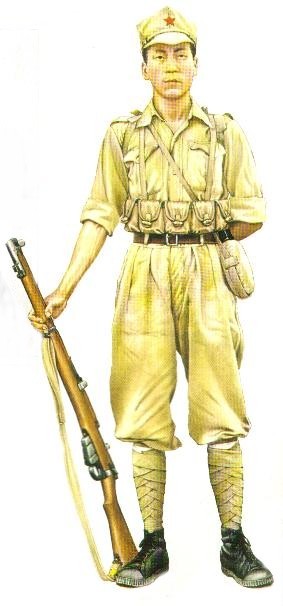|
The Malayan Races Liberation Army
The communist-led Malayan Races Liberation Army (MRLA) came into being in 1948 as the military arm of the Malayan Communist Party's (MCP) attempt to oust the British from Malaya and gain control of the peninsula. As a guerrilla organisation the MRLA had the great advantage of being able to recruit men who had gained valuable military experience when acting as part of the communist Malayan People's
Anti Japanese Army (MPAJA). Although disbanded in 1945, MPAJA commanders had ensured that caches of arms and ammunition were safely stored away should the need for armed struggle again arise. Despite this, however, the MRLA was forced to operate within a complex politico-military and racial situation which, when faced by determined British resistance, was to ensure that the communist insurrection would ultimately fail.
Following a campaign of civil unrest by the MCP in the urban centres, the struggle was extended into the military sphere in July 1948. Able to raise and equip some 3000 guerrilla fighters the MRLA was organised on conventional military lines with a structure that ranged from the platoon up to units at battalion and regimental level, though the latter were more an organisation on paper, being clearly unable to take on British forces at the level of full-scale operations. Nonetheless, like many guerrilla organisations before and after them, the MRLA made the initial mistake of attempting to mount relatively large military operations which played into the hands of the British who could then locate the guerrillas (the hardest part of counter- insurgency warfare) and destroy them in open combat.
Once the error of this strategy was realised the MRLA adopted the traditional guerrilla approach of isolated ambushes, assassination of key figures, and the carrot-and- stick policy of intimidation and aid to the local population. On the organisational side, units were correspondingly reduced in size, typically to raiding parties of less than a dozen men, although the base camps remained skilfully hidden in the Malay jungle. Winning over the people to the revolutionary cause proved to be especially difficult; the fairly even divide of the population into Malays and Chinese was not necessarily a problem but as the vast majority of the MRLA were of Chinese stock the ordinary Malays failed to identify with the guerrillas and consequently had little interest in the MCP's aims.
At its peak the MRLA had a strength of around 10,000 men but it was faced by well-organised and numerically superior government forces which amounted to some 60,000 police and auxiliary units and 30,000 regular troops. The type of war waged by the MRLA was cat-and-mouse attack and counterattack fighting where
ambushes could easily find themselves ambushed. Long, strenuous marches along
winding jungle tracks, setting up ambushes and avoiding them in return, conducting surveillance operations and assassinations and the sabotage of Malay
industry formed the tactical background to the MRLA guerrilla. The overall strategy was to terrorise the peasant population, alienate them from their masters and bring about the destruction of Malaya's economic wealth, based largely on its extensive rubber plantations. That the MRLA did not succeed was mainly due to the generally intelligent counter-measures adopted by the government forces in preventing the guerrillas from subverting the loyalty of both the urban and rural populations.
The MRLA soldier was a hardy fighter often operating under the most difficult physical circumstances for long periods of time. Altogether nearly 7000 MRLA guerrillas were killed in the conflict, which lasted 12 years from July 1948 until July 1960 when the State of Emergency was officially ended. That the MRLA - grossly inferior in men and materials and lacking any realistic hope of victory - held out for so long was testimony to the grit of its soldiers.
|


